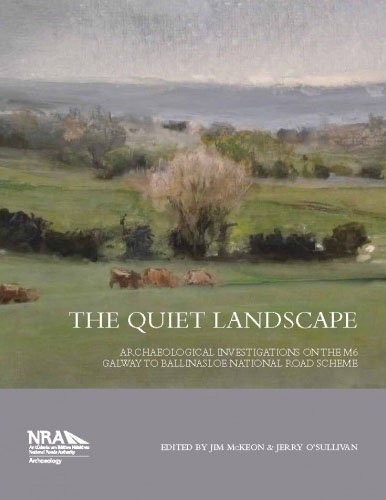
This volume represents one of a series instigated by the explosion of archaeological excavations undertaken in the Republic of Ireland in the mid-2000s. Commissioned by the National Roads Authority (NRA), this book details the results of the archaeological investigations completed in advance of the construction of the M6 Motorway between Ballinasloe and Galway, Co. Galway. These excavations were undertaken in 2005-7; one a number of road schemes across Ireland from 2000 onwards. I worked as an archaeological supervisor for Eachtra Archaeological Projects on the excavation of the early medieval hillfort and later cillin at Mackney (p.187-200), but did not contribute to this volume.
The book is 232 pages in length, well-illustrated with maps, photographs, plans and reconstruction drawings, and divided into five chapters. The first chapter describes the circumstances of the investigations and the methodologies imposed, as well as a period-by-period summary of the archaeological background of the area. The four following chapters each detail the four ‘sectors’ of the road scheme; each excavated by four different companies; Valerie J Keeley, Headland Archaeology Ireland (now Rubicon Heritage Services), CRDS and Eachtra Archaeological Projects. These chapters each provide a short description and interpretation of each of the excavated sites written by the Site Directors. The wide variety of sites investigated as part of the road scheme range from the prehistoric (Late Mesolithic/Early Neolithic campsite and Bronze Age trackway at Ballynacloch – p.147-54) to the post-medieval (Spade mill and lime kiln at Coololla, p.162-168), and from the common (Burnt mounds at Doughiska – p.36-39, Newford – p.54-56, , Caraun More – p.98-99, Cooltymurraghy – p162, Urraghy & Barnacragh – p168-172 ) to the unusual (Bronze Age timber platforms at Killescragh – p.86-92 and Bronze age hillfort at Rahally – p.105-115). An impressive collection of Early Medieval ringforts (Rahally p.105-115, Loughbown 1 & 2 – p.172-184 Loughbown 2, Mackney - p.187-200) and Cashels (Carnmore West – p.45-50, Farranblake East - p.57-8) were also excavated, including the complete investigation of the hillfort at Mackney, tracing occupation from the 8th to 18th century. While the layout of these chapters allowed for the allocation of the sites to each archaeological company, it would have also been beneficial to include a summary section at the end to fully integrate the results for each period across all four sectors.
What this book does particularly successfully is be accessible to a wide audience, both enthusiasts and professionals alike. Part of the remit of the NRA during the excavation of the M6 road scheme was to communicate the results to the local population, through public lectures and site visits and culminating in this publication forming the ‘keystone in this programme of public communications’ (p15). This book is written to educate those outside the archaeological profession, but is sufficiently detailed to be a reference text for those examining the archaeological remains of the area. This is achieved in part through the inclusion of a well-presented and organised supplementary disc that holds the detailed post-excavation reports for each site and allows the interrogation of the archaeological remains in detail. From an academic prospective it would be beneficial to also see detailed individual publications for some of the more interesting sites, particularly in the wider context of recent archaeological discoveries across Ireland.
On a personal note this book brings back many good memories of living and working in Ballinasloe in 2006, with a great group of archaeologists from across the world, many of which I still call friends. After working with many archaeologists in the UK who similarly spent part of their career working in Ireland, I believe that my good experiences were not exceptional but mirrored those of many of the people involved.
